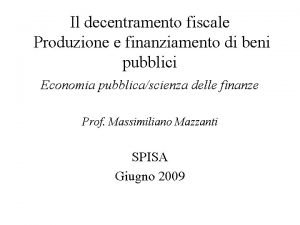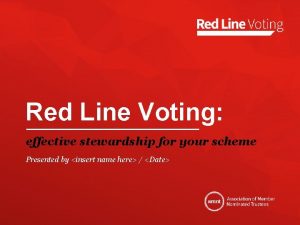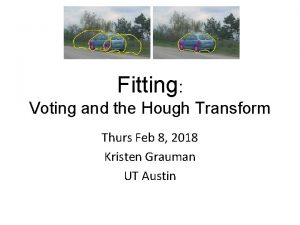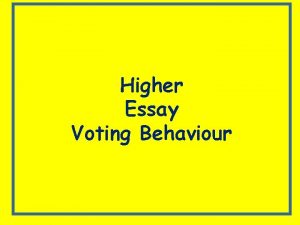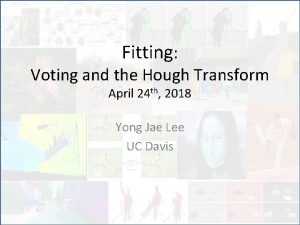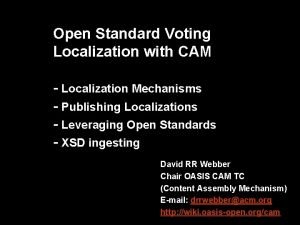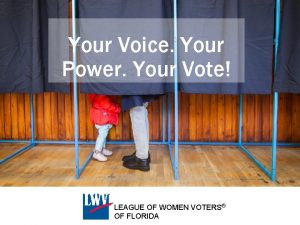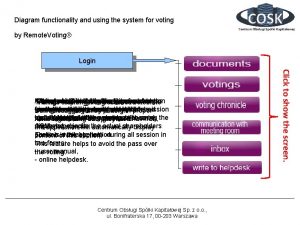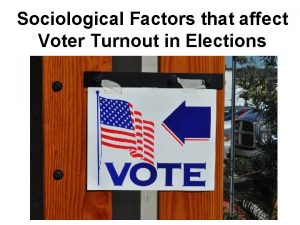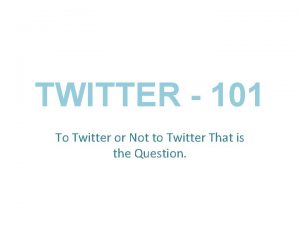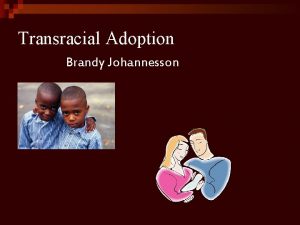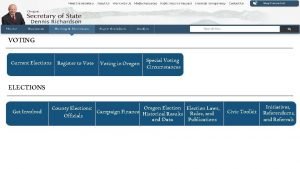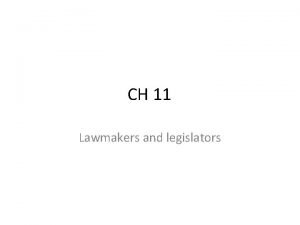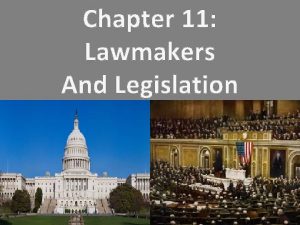The Impact of Twitter Adoption on Lawmakers Voting





















- Slides: 21

The Impact of Twitter Adoption on Lawmakers’ Voting Orientations Article Review Billy Spann IFSC 7310 Spring 2019

Reference Citation • The Impact of Twitter Adoption on Lawmakers’ Voting Orientations • Mousavi, Reza, and Bin Gu. “The Impact of Twitter Adoption on Lawmakers’ Voting Orientations. ” Information Systems Research, 2019, doi: 10. 1287/isre. 2018. 0791 Also available at: SSRN: https: //ssrn. com/abstract=2453006 or http: //dx. doi. org/10. 2139/ssrn. 2453006

Introduction • Online social networking (OSN) platforms facilitate the participation of consumers and public in business, government decision making processes, and political campaigns. • However, little is known about the degree to which participation affects firms or organizations’ decision outcomes • This study examines whether the adoption of Twitter by U. S. Representatives in Congress makes them more likely to vote in line with the political ideology of their constituents.

Social Media in Politics • Social media helps lawmakers communicate their messages to constituents, but also provides constituents with a channel to interact with their representatives in a convenient way. • In the House of Representatives, 75% had both Twitter and Facebook • One study discovered 7. 4% of tweets posted by Members are for 1 -on-1 communication with constituents. • Congressional Management Foundation reports 42% of the 138 surveyed senior managers and social media managers in Congressional offices consider Twitter an important tool for understanding constituents’ view and opinions.

Contributions • The focus of existing literature on societal and political impact of IS has been on participation and engagement with OSNs, and less on societal outcomes. • Studies around societal issues reveal different levels of societal impact to Information Systems. • Three distinct informational benefits drive the impact of information-rich networks • Access • Timing • Referrals

The Study • It is not clear to what extent the adoption of Twitter truly influences political decisions. • The authors constructed a panel of data for 445 members of the 111 th U. S. House of Representatives across a period of 24 months (Jan. 2009 – Dec. 2010) • A fixed effects and differences-in-differences (DD) model were used along with Propensity Score Matching • Goal: • Estimate the monthly measure of Representatives’ voting orientations based on votes cast

Estimator Model • Weighted Nominal Three-Step Estimation (WNOMINATE) model • Produces matrix of binary choices by individuals • Widely used estimation model in political science (K. Poole and H. Rosenthal) • The estimate produces a table of legislators and outcome points for Yea and Nay records for each roll call. • Identifies political misalignment between Reps and constituents

Dependent Variables • Representatives Voting Orientation • Weighted Nominal Three-Step Estimation (WNOMINATE) model • Produces matrix of binary choices by individuals • The estimate produces a table of legislators and outcome points for Yea and Nay records for each roll call. political misalignment • Constituents Voting Orientation • Constituents estimate-scores are based on how Congressional district leans (Democrat or Republican) • Seven large-scale national surveys from 2006 -2011 using item response theory

WNOMINATE Scores

Predictor and Control Variable Statistics • First collected background statistics • Out of 445 Representatives, 246 had Twitter accounts by the end of the 111 th Congress (204 net adds, 42 existing accounts) • Authors developed a binary adoption indicator by month (twitter status) for each Representative • They also collected • All tweets posted by Reps. during each month • All tweets where Reps. Twitter handles were mentioned • All tweets where Reps. First and last names were mentioned

Descriptive Statistics *political misalignment captures the distance between the Representatives voting orientations and the constituent’s political ideologies.

Instrumental Variables • Valid instruments need to correlate with the decision to adopt but affect the dependent variable only through the adoption decision. • We want to know causal effect of treatment on outcome (not just correlation) Instrument • name-mentions frequency • committee effect • neighbor effect External Variables (pre-treatment variables) Treatment Outcome • adopting Twitter • voting orientation * Not causal inference

External variables

Methodology • The adoption of Twitter allows us to examine voting preferences before and after adopting Twitter. • Does the variation in adopting Twitter impact voting behavior? • To assess this effect, they use the following model: , where i = index for Representative and t = index for time ���� is a dummy var. that takes the value of 1 if Rep. i is an eventual adopter, and 0 otherwise �� 2 is difference-in-differences estimator that captures adoptions effect on voting orientations

Methodology • Authors ran 6 models • Model 1: Fixed effects (FE) with 2 SLS specification • Model 2: Ordinary Least Squares (OLS) with 2 SLS specification • Model 3: Zero-one inflated beta distribution (ZOIB) specification (also used in pol. sci. ) • Models 4 -6: similar as models 1 -3 above but using political misalignment as outcome var. • Model features: • The fixed effects controlled for observed and unobserved time invariants such as age, gender, longevity of service, and constituents’ characteristics across the Representatives.

Results • Spectrum of scores ranging from -1 to +1, with -1 representing the most liberal Representative and +1 representing the most conservative Representative • Compared to non-adopters, eventual adopters had much lower voting orientation before they adopted Twitter • Adopters became more conservative after joining Twitter. • Adoption by Reps. From less conservative districts was slightly higher than that of Reps. From more conservative districts. • Among adopter districts, political misalignment becomes 14. 1% smaller after the adoption.

Sample Result – Voting Orientation

Conclusion • The authors set out to examine whether the adoption of Twitter by U. S. Representatives in Congress makes them more likely to vote in line with the political ideology of their constituents. • Using their estimation model with instrumental variables, they applied three different statistical methods to the data. • They determined that the adoption of Twitter, did indeed, direct the Representatives to vote more in line with their constituents.

Limitations • Limited to the sample of U. S. House of Representatives • Similar names in the ‘name-mention tweets’ could distort accuracy of dataset • We don’t know for name-mention and handle-mention tweets if those were sent by the actual constituents. • Need to better understand the politician network in social media. • Only used Twitter, could extend to other OSNs.

Results - Backup

Fixed Effects vs Differences-in-Differences • The fixed effects model assumes • The differences-in-differences model makes a similar assumption but conditions on a group level instead of an individual level effect.
 Digital adoption platform impact
Digital adoption platform impact Voting by feet tiebout
Voting by feet tiebout Vtools enotice
Vtools enotice Deployment diagram for online voting system
Deployment diagram for online voting system Red line voting
Red line voting Imf voting power
Imf voting power Online voting system project proposal
Online voting system project proposal Hough voting
Hough voting Ams voting system pros and cons
Ams voting system pros and cons Block diagram of mobile phone
Block diagram of mobile phone Compulsory voting essay
Compulsory voting essay Meetoo live polling
Meetoo live polling Hough voting
Hough voting Instant runoff voting excel template
Instant runoff voting excel template Voting districts definition ap human geography
Voting districts definition ap human geography Brainpop voting
Brainpop voting Voting rights
Voting rights Polling with vevox
Polling with vevox Activity diagram for online voting system
Activity diagram for online voting system What are the four common methods of voting in ffa
What are the four common methods of voting in ffa Sociological factors that affect voting behavior
Sociological factors that affect voting behavior Which statement best summarizes the soldier's thoughts
Which statement best summarizes the soldier's thoughts

